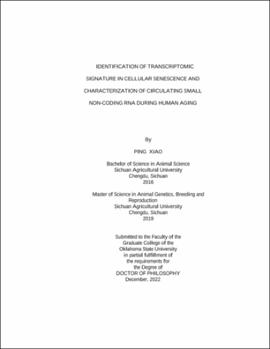| dc.contributor.advisor | Hagen, Darren E. | |
| dc.contributor.author | Xiao, Ping | |
| dc.date.accessioned | 2023-07-05T20:56:52Z | |
| dc.date.available | 2023-07-05T20:56:52Z | |
| dc.date.issued | 2022-12 | |
| dc.identifier.uri | https://hdl.handle.net/11244/337885 | |
| dc.description.abstract | Accumulation of cellular senescence always forebodes the initialization of aging and cancer. It is an irreversible process that leads to cell cycle arrest while senescent cells still own metabolic viability to affect tissue homeostasis. Senescent cells not only accelerate individual aging process, they are also the driver of age-related diseases such as cancer, osteoarthritis, atherosclerosis, and Alzheimer’s diseases. Senescent phenotype shows heterogeneity in different cell lines under diverse triggers, and blurred traits with non-senescent cells make it difficult to identify senescence precisely. It is very necessary to identify robust shared markers, senescence-specific pathways and biological processes across different senescence models. Recently the emerging role of non-coding RNA in senescence and aging has been noticed due to its ability to control cell cycle at post-transcriptional level. Usually the highly proactive secretome from senescent cells, termed the senescence-associated secretory phenotype (SASP), can result in age-related process through intercellular communication, whereas only a number of factors have been identified in very specific scenarios and the role of secreted extracellular RNAs (exRNAs) is not well understood. Detection of exRNAs protected by EV membrane uncovered the fact that most of extracellular mRNAs are fragmentation, along with small non-coding RNAs (sncRNAs), such as miRNAs, piRNA and tRNA fragments. Therefore it is promising to uncover the role of extracellular sncRNA in aging related dysfunction during cell-cell interaction.To better understand the nature of cellular senescence and its corresponding human aging process at transcriptome level, RNA sequencing data from different cell types and senescence inductions were collected, and significantly shared gene markers and pathways among multiple senescence models were determined through meta-analysis and machine learning-based logistic regression methods. Extensionally, the function of identified senescence associated long non-coding RNAs (lncRNAs) during cell cycle were verified through short interfering RNAs (siRNAs) knock-down treatment in lung fibroblasts (IMR-90). In parallel, the abundance of extracellular sncRNAs from healthy people aged 20 to 99 was quantified using 446 small RNA sequencing datasets. The expressional trends of each sncRNA subspecies were detected with age and a sncRNAs-based age predictors was established using high performance ensemble machine learning strategy. | |
| dc.format | application/pdf | |
| dc.language | en_US | |
| dc.rights | Copyright is held by the author who has granted the Oklahoma State University Library the non-exclusive right to share this material in its institutional repository. Contact Digital Library Services at lib-dls@okstate.edu or 405-744-9161 for the permission policy on the use, reproduction or distribution of this material. | |
| dc.title | Identification of transcriptomic signature in cellular senescence and characterization of circulating small non-coding RNA during human aging | |
| dc.contributor.committeeMember | Subramanian, Madhan | |
| dc.contributor.committeeMember | Moraes, Joao G. N. | |
| dc.contributor.committeeMember | Burnap, Robert L. | |
| osu.filename | Xiao_okstate_0664D_17941.pdf | |
| osu.accesstype | Open Access | |
| dc.type.genre | Dissertation | |
| dc.type.material | Text | |
| dc.subject.keywords | age predictor | |
| dc.subject.keywords | cellular senescence | |
| dc.subject.keywords | human aging | |
| dc.subject.keywords | machine learning regression | |
| dc.subject.keywords | non-coding RNAs | |
| dc.subject.keywords | transcriptomic signatures | |
| thesis.degree.discipline | Animal Science | |
| thesis.degree.grantor | Oklahoma State University | |
